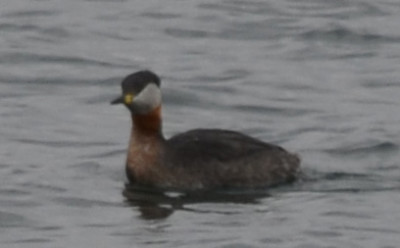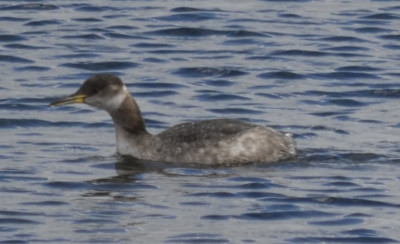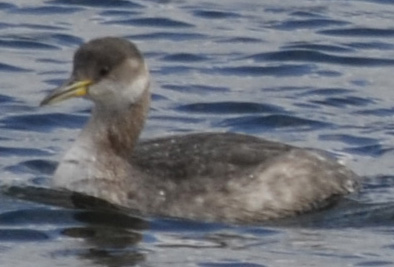I’ve mentioned before that bird watchers can be a funny bunch. For some reason a bird in the wrong place, or in the right place at the wrong time, seems to flush birders out of their basements like the shriek of a peregrine on the roof. In 2014, reports have been made almost daily of a Western Grebe spotted in Lake Ontario off Colonel Sam Smith Park in Etobicoke (Toronto.) Two recent visits to the park showed me a steady stream of sensibly-dressed persons toting spotting scopes, industrial-strength binoculars and cameras down to the shore and around to the western side of the marina bay. They were looking for the Western Grebe, and no simple Red Necked was going to satisfy them.
What’s a Western Grebe Doing in the East?
Western Grebes almost make it into Ontario in the summer most years. According to the Nature Canada website, they are reported as breeding residents right up into the land between Lake Superior and Lake Michigan. They don’t normally winter, there, though. So this migrating Grebe apparently headed east into the Great Lakes, instead of west to the Pacific coast or south towards the south-western US.
Rambling Along the Waterfront Looking at Waterfowl
When I first went to Colonel Sam Smith Park, I admit I kept my eyes open. While I don’t make a habit of racing out to see every unusual bird in the area, I don’t mind seeing them while I’m already on a ramble. So as I admired the way a merganser wouldn’t allow itself to be bullied by gulls, I also kept shooting photos of any waterfowl on the Lake.
At one point, I noticed a pair of birds swimming rapidly east that looked vaguely like Mergansers, but not quite. They seemed to have slender necks. They also swam with a funny habit of slightly extending then pulling back on their necks as if tugging themselves forward through the water. I shot a sequence of photos knowing that without those industrial-strength binoculars mentioned above I wouldn’t be able to see what the birds were while I was here. Given the dark gloomy weather, I wasn’t sure if the camera could capture them either.
Along the western shore facing into the main Lake, I saw another set of similar birds and shot some more photos. The number of similar birds I was seeing told me they wouldn’t be the solitary Western Grebe, but I was cautiously hopeful they might be Grebes. Any kind of Grebes. Unlike some of my more picky birding brethren, I would be quite content with a Grebe, be it Pied, Horned or Red-necked.
One hopefully-a-grebe bird I took photos of was solo in amongst a flock of Gadwall ducks. I did think quietly to myself as I watched yet another overloaded photographer hurrying along the shore that it would be ironic indeed if this little grey guy was the Western Grebe. (As it turns out, it wasn’t, but I still think those others didn’t even notice that ANY grebe was a few hundred metres away from them as they rushed in pursuit of more precious prey.)
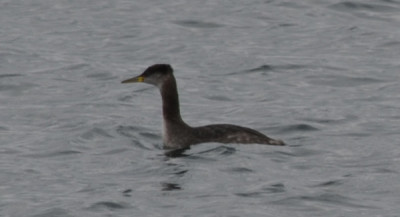
Still another Red-necked Grebe
Let’s Get Right to the Point: What IS a Grebe?
One of the first questions I asked myself while warming up later with a hot mug of tea was “What exactly IS a grebe?” I knew the name and I vaguely knew the size and shape from my Peterson’s Field Guide, but I didn’t really know what made them different from, say, a duck.
In many ways they are similar to diving ducks: they eat fish, crustaceans or mollusks, depending on the species. They have feet set fairly far back on their bodies which are excellent for diving but not so good for walking on land. These Ontario species of grebes have to migrate so they are reasonably good fliers once they get up in the air. (There apparently are some flightless types of Grebes in southern areas.) These were the similarities I found when browsing around the internet and visiting AllAboutBirds.org.
One cool fact: The New Jersey Fish and Wildlife website says that Pied Grebes can actually adjust their buoyancy by compressing air out from between their feathers. This allows them to dive deeper and longer without popping back up. Apparently some of their feathers grow straight out from their skin, then curl near the tips. So the feathers can trap lots of air when relaxed, but it gets squeezed out when the feathers are pressed in.
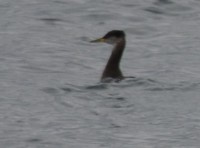
A Red-necked Grebe showing off
According to the Royal Society for the Protection of Birds, grebes have pointed bills of varying lengths, round bodies, and tiny tails. Grebes have widened toes with some webbing near the base for swimming. They usually nest on anchored floating vegetation.
According to Wikipedia, the main reason grebes are in a group of their own is that their anatomy is radically different from other birds like ducks. I’d like to pursue this further but I guess it will have to be the subject of another post another day.
My Late Winter Lake Ontario Grebes are Red Necked Grebes
All of the grebes I took photos of during this breezy and cloudy ramble were Red-Necked Grebes. Some were easy to identify because they were already starting to show their summer plumage. Others in their winter plumage I had to confirm by checking with the birding community on Ontario Birds.
I’ve since heard that there are also some Horned Grebes at the same park. The next time I go for a ramble down that way, I’ll keep taking photos and hope that I find them. And if I see the Western Grebe I’ll be pleased. But if I don’t I will also be pleased.
Related Reading
- Spring Snow Bunting Shows Off at in Colonel Sam Smith Park, Toronto, Ontario
- An Otter? An Ermine? A Weasel? Nope, It’s a Mink I Think at an Etobicoke Park on Lake Ontario
- Why Is This Grebe Carrying Zebras on Its Back?
Join In
Have you watched Grebes in the winter fishing in Lake Ontario? Or in the summer while they tote their tiny chicks about on their backs? Please share your experiences with a comment.

